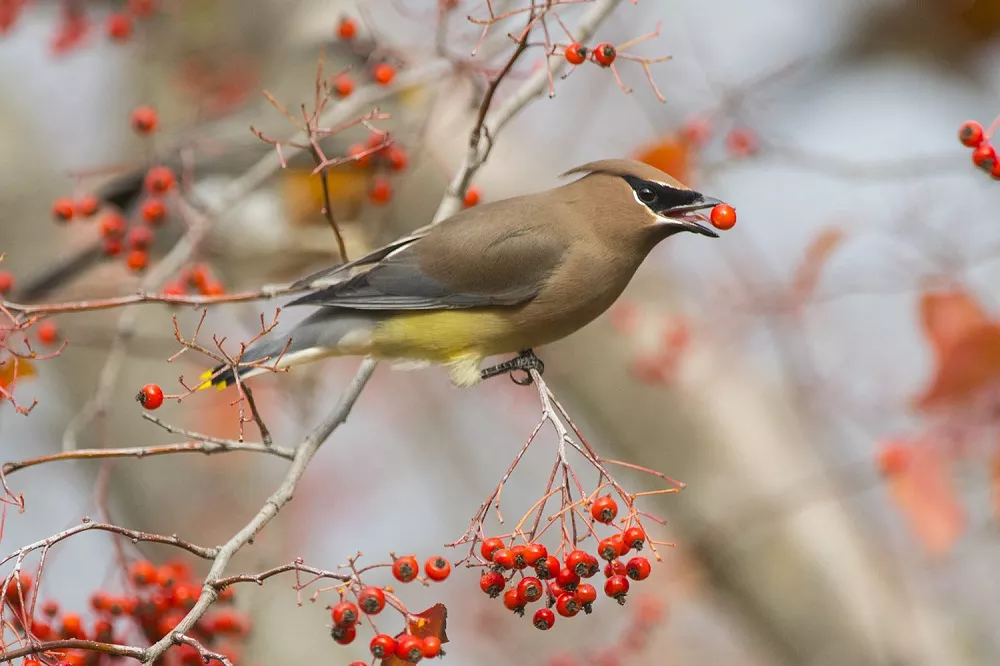The Cedar Waxwing (Bombycilla cedrorum) is a bird species that captivates with its distinctive appearance and elegant demeanor. From its sleek plumage to its unique markings, the Cedar Waxwing stands out as a visual delight in the avian world. In this article, we explore the physical characteristics, plumage details, and other notable features that define the striking appearance of the Cedar Waxwing.
Physical Characteristics:
The Cedar Waxwing possesses several notable physical features that contribute to its overall charm and visual appeal. Here are the key characteristics that define this bird:
Size and Shape: The Cedar Waxwing is a medium-sized songbird, measuring around 6 to 7 inches (15 to 18 cm) in length. It has a slender, elongated body with a slightly crested head, giving it an elegant silhouette.
Plumage and Colors: The waxwing’s plumage is sleek and soft, with a silky texture that adds to its visual appeal. The overall coloration is a combination of soft shades that create a subtle yet striking appearance. Key features include:
Crested Head: The Cedar Waxwing boasts a small, pointed crest on its head that can be raised or lowered depending on its mood or level of excitement.
Brownish-Gray Upperparts: The upperparts of the Cedar Waxwing are predominantly brownish-gray, with a slight olive tinge. This coloration extends from the crown to the back and wings.
Pale Yellow Belly: The underparts, including the belly and undertail coverts, are a pale yellow color, adding a touch of brightness to the bird’s overall appearance.
Black Mask and Throat: One of the Cedar Waxwing’s most distinctive features is its black mask, which extends from its bill to its eyes. This mask contrasts sharply with its pale yellow belly. Additionally, it sports a narrow black band across its throat.
Wax-Like Red Tips: The waxwing’s secondary wing feathers exhibit wax-like red tips, which appear as if the bird has dipped its wings in melted wax. These bright red tips add a vibrant burst of color and are particularly noticeable during flight.
Tail and Flight: The Cedar Waxwing has a short, squared-off tail. During flight, its wings appear relatively broad and rounded, enabling agile maneuvers and elegant gliding.
Notable Behaviors:
In addition to its striking appearance, the Cedar Waxwing exhibits a range of notable behaviors that further enhance its allure:
Social Behavior: Cedar Waxwings are highly social birds, often found in flocks that can number in the dozens or even hundreds. Their flocking behavior is particularly prominent during the winter months when they gather in communal feeding flocks.
Synchronized Flight: When Cedar Waxwings take flight, they showcase a remarkable display of coordination. They fly in tight formations, often in undulating patterns, displaying a synchronized and graceful flight style.
Diet and Feeding Habits
Cedar Waxwings are primarily fruit-eating birds and have a unique feeding habit. They often feed in flocks, and when they find a tree with ripe fruit, they all group together and eat the fruit until it is gone. This behavior is known as “communal feeding.”
Their diet consists of various fruits, including berries, cherries, and grapes. They also consume insects during the breeding season to provide protein for their young.
Breeding and Nesting
The Cedar Waxwing breeds in late spring to early summer and forms monogamous pairs. The female lays between 3-5 eggs, which are incubated by both the male and female for around 12-14 days. Once hatched, both parents feed and care for their young until they fledge, which takes around 14-18 days.
Cedar Waxwings do not build typical bird nests. Instead, they construct a small platform of twigs and grasses, which they line with softer materials like feathers and moss. They often build their nests on horizontal branches close to the trunk of a tree.
Habitat and Distribution
Cedar Waxwings can be found throughout most of North America, from southern Canada to Central America. They inhabit a variety of environments, including coniferous and deciduous forests, orchards, parks, and gardens.
Conclusion:
The Cedar Waxwing’s appearance is truly a visual delight. With its sleek plumage, crested head, striking black mask, and wax-like red wingtips, this bird captures the attention and admiration of bird enthusiasts and nature lovers alike. Understanding the physical characteristics and behaviors of the Cedar Waxwing allows us to appreciate its unique beauty and the role it plays in the natural ecosystems it inhabits.
Related topics:


 Facebook
Facebook  Instagram
Instagram  Youtube
Youtube 